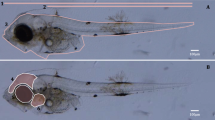Abstract
The toxicity of total residual chlorination (TRC) to early life stages of the striped bass,Morone saxatilis, was determined using percent embryo hatchability, incipient LC50 bioassays, histopathology, and avoidance responses.
Beginning 8 to 9 hours after fertilization, developing embryos were exposed continuously to TRC in flowing water at 1.0–3.0 ppt salinity and 18±1C. Fifty-six percent of the control group (no TRC exposure) hatched. None of the embryos exposed to a measured TRC concentration of 0.21 mg/l hatched. Only 3.5 percent of the embryos exposed to 0.07 mg/l TRC and 23 percent of those exposed to 0.01 mg/l TRC hatched.
Incipient LC50 bioassays were used to determine the sensitivity of 2-, 12- and 30-day-old striped bass to concentrations of TRC in flowing water (1.0–3.0 ppt salinity at 18±1C). The estimated incipient LC50 was 0.04 mg/l TRC for 2-day-old prolarvae, 0.07 mg/l for 12-day-old larvae and 0.04 mg/I for 30-day-old juveniles.
Histological examination of 30-day-old juveniles which survivel exposure in the incipient LC50 bioassay indicated gill and pseudobranch damage for fish exposed to 0.21 to 2.36 mg/I TRC.
Statistical analysis of avoidance tests conducted at 1.0–3.0 ppt salinity and 18±1C with 24-day-old larvae showed significant (X2, p<0.05) and reproducible avoidance responses to measured TRC concentrations of 0.79–0.82 mg/I and 0.29–0.32 mg/I. No avoidance was indicated at TRC concentrations of 0.16–0.18 mg/I.
Similar content being viewed by others
Literature Cited
Albrecht, A. B. 1964. Some observations on factors associated with survival of striped bass eggs and larvae.Calif. Fish. Game, 50(2):100–113.
Alderson, R. 1972. Effects of low concentrations of free chlorine on eggs and larvae of plaice,Pleuronectes platessa L. p. 312–315.In M. Ruivo (ed.), Marine Pollution and Sea Life. Fishing News (Books) Ltd, London.
— 1974. Seawater chlorination and the survival and growth of the early developmental stages of plaice,Pleuronectes platessa L., and Dover sole,Solea solea (L).Aquaculture 4:41–53.
American Public Health Association, American Water Works Association and Water Pollution Control Federation. 1971. Standard methods for the examination of water and wastewater. 13th ed. New York, New York. 834 p.
Ashley, L. M. 1975. Comparative Fish Histology, p. 3–30.In The Pathology of Fishes. Eds: Ribelin and Migaki. Univ. of Wisconsin Press.
Bayless, J. D. 1972. Artificial propogation and hybridization of striped bass,Morone saxatilis (Walbaum). South Carolina Wildlife and Marine Resources Dept. Report. 135 p.
Bigelow, H. B., andW. C. Schroeder. 1936. Supplemental notes on the fishes of the Gulf of Maine.Bull. U.S. Bur. Fish. 48:319–343.
—, AND —. 1953. Fishes of the Gulf of Maine.Bull. U.S. Bur. Fish. 53:1–577.
Dovel, W. L. 1967. Fish eggs and larvae of the Magothy River, Maryland.Chesapeake Sci. 8(2):125–129.
Dovel, W. L. 1971. Fish eggs and larvae of the upper Chesapeake Bay. Natural Resources Institute, Univ. of Maryland, Special Scientific Report, 4:1–71.
Environmental Protection Agency. 1974. Handbook of analytical quality control in water and wastewater laboratories. Analytical Quality Control Laboratory, National Environmental Research Center, Cincinnati, Ohio. 45 p.
Grothe, D. R., andJ. W. Eaton. 1975. Chlorine-induced mortality in fish.Trans. Am. Fish. Soc. 104(4):800–802.
Meldrim, J. W., J. J. Gift andB. R. Petrosky. 1974. The effect of temperature and chemical pollutants on the behavior of several estuarine organisms. Ichthyological Assoc. Inc. Bull. No. 11:1–129.
Merriman, D. 1941. Studies on the striped bass (Roccus saxatilis) of the Atlantic Coast. Fish. Bull. U.S. Fish Wildl. Serv., No. 50:1–77.
Middaugh, D. P., A. M. Crane and J. A. Couch. 1977. Toxicity of chlorine of juvenile spot,Leiostomus xanthurus. Submitted to Water Research.
Pearson, J. C. 1938. The life history of the striped bass, or rockfish,Roccus saxatilis (Walbaum).Bull. U.S. Bur. Fish. 49(28):825–851.
Raney, E. C. 1952. The life history of the striped bass,Roccus saxatilis (Walbaum).Bull. Bingham Oceangr. Coll. 14(1):5–97.
Servizi, J. A., andD. W. Martens. 1974. Preliminary survey of toxicity of chlorinated sewage to sockeye and pink salmon. Pacific Salmon Fisheries Commn. Progress Report No. 30:1–42.
Snedecor, G. W. 1956. Statistical Methods. 5th ed. Iowa State College Press. Ames, Iowa 534 p.
Sokal, R. R., andJ. F. Rohlf. 1969. Biometry, the principles and practice of statistics in biological research. W. H. Freeman and Co., San Francisco, Calif. 776 p.
Sprague, J. B. 1964. Lethal concentrations of copper and zinc for young Atlantic salmon.J. Fish. Res. Board Can. 21:17–26.
— 1968. Avoidance reactions of rainbow trout to zinc sulphate solutions.Water Research 2:367–372.
— 1969. Measurement of pollutant toxicity to fish. I. Bioassay methods for acute toxicity.Water Research 3:793–821.
Tresselt, E. F. 1952. Spawning grounds of the striped bass,Roccus saxatilis (Walbaum), in Virginia.Bull. Bingham Oceanogr. Coll 14(1):98–110.
Tsai, C. 1970. Changes in fish populations and migration in relation to increased sewage pollution in Little Patuxent River, Maryland.Chesapeake Sci. 11(1):34–41.
Vladykov, V. D., andD. H. Wallace. 1938. Is the striped bass (Roccus lineatus) of Chesapeake Bay a migratory fish?Trans. Amer. Fish. Soc. 67:67–86.
Worth, S. G. 1884. The propogation of the striped bass.Trans. Amer. Fish Cultural Assoc. 209–212.
— 1903. Striped bass hatching in North Carolina.Trans. Amer. Fish. Soc. 32:98–102.
Author information
Authors and Affiliations
Additional information
Gulf Breeze Contribution Number 304
Rights and permissions
About this article
Cite this article
Middaugh, D.P., Couch, J.A. & Crane, A.M. Responses of early life history stages of the striped bass,Morone saxatilis to chlorination. Chesapeake Science 18, 141–153 (1977). https://doi.org/10.2307/1350386
Issue Date:
DOI: https://doi.org/10.2307/1350386




